Giant, invasive joro spiders set to spread on US east coast – but pose no significant threat
The US north-east is preparing for a new pest invasion this summer, as giant venomous spiders known as joro spiders are expected to make a larger appearance in states like New York and New Jersey. Originating from east Asia, these spiders measure up to 4 inches in length with legs as long as 8 inches, resembling the size of a human hand. While females boast bright yellow bodies, males are typically smaller and brown in color.
Having been present in the US for at least a decade, the joro spider was first spotted in Georgia, most likely arriving in the country through a shipping container. Earlier predictions in 2022 suggested that the joro spider would be making its way to the US east coast. However, a recent study conducted by David Coyle, an assistant professor at Clemson University, indicates that these giant spiders are here to stay and are expected to inhabit a significant portion of the eastern US.
According to Coyle, the spiders are likely to expand their range further north, with existing populations already observed in Maryland. Unlike other spider species, joro spiders are well-suited to the east coast’s climate, which closely resembles their native Japan. Furthermore, a study from the University of Georgia revealed that these spiders are comfortable thriving in urban environments, unfazed by busy roads and likely to spread and populate cities.
Despite their intimidating appearance, joro spiders pose no real threat to humans or pets. These arachnids are known to be shy and prefer constructing their webs outdoors rather than inside homes. Reports of Joro spider bites have been rare, with affected individuals experiencing mild symptoms such as swelling, slight fever, and redness, possibly attributed to allergic reactions.
In conclusion, while the spread of joro spiders on the US east coast may raise concerns, it is essential to note that these creatures do not pose a significant danger and are unlikely to cause harm to humans or pets.


